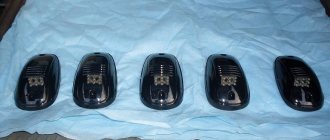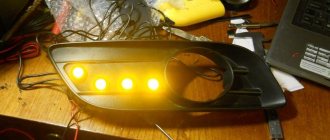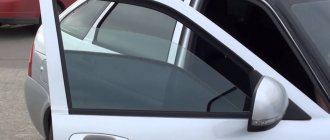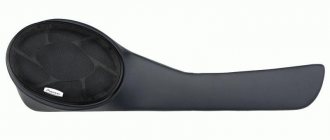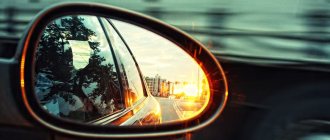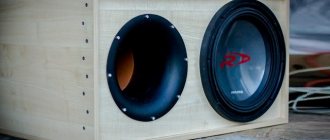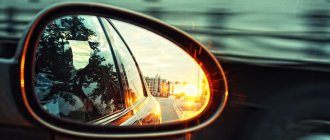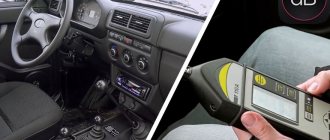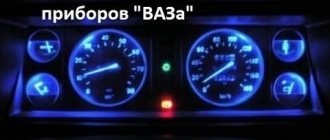If the device begins to take a long time to respond to commands and displays various malfunctions, a forced system rollback to factory settings may help. Updating the data cache by cleaning the internal space will allow the device to return to its original operating speed and speed of response to the owner’s wishes.
Before formatting system files, it is recommended to save all important information on a removable memory card.
To reset the settings, you need to:
- Find the “System Settings” item in the menu.
Select the sub-item “Return to factory settings”.
If the reboot does not help, you will have to contact a service center authorized by the manufacturer for warranty service.
, please select a piece of text and press Ctrl+Enter.
Setting up a DVR is the main problem faced by most owners of this important car accessory. Considering that many people are now buying a Chinese car recorder, it is not surprising that such questions arise. Of course, if you buy an accessory in a regular store, you can ask a sales assistant, and he will help you sort out all the issues, but if you ordered the device online, you will have to set up the DVR yourself.
How to set up a DVR
How to properly set up a DVR? After you turn on your device for the first time, it may behave differently. Some models offer disk formatting. If this is about your model, click on “Yes”. After this point, you can move on to other settings.
Among the main settings is the choice of language. The Chinese, of course, will set either their language or English by default, but most Russians are more comfortable if the device speaks their native language. However, keep in mind that not all models can correctly translate their content into Russian, so be prepared for surprises.
The next important point is to remember to set the time and date. The recorder is needed primarily to record the chronicle from the scene of the incident. It will be very strange if the time on the recorded video dates back to, for example, 1920. Make sure that the correct date and time are indicated on the recorder. You can set them in the system settings of the car DVR - find the item responsible for the date and change it; as a rule, it is called “Date and time”.
Constantly check the data of the established indicator for reliability - the correct indicators will help you, if necessary, defend your case.
Setting video quality and resolution
The DVR settings also include such an item as setting the required video quality and resolution. Many modern models allow you to set the optimal mode - Full HD quality, but for a good picture you will only need to set the quality to 1080p - all the necessary details can be seen in this mode.
Please note that the recorder needs to adjust the exposure. This greatly affects how light or dark the picture will be. The answer to the question of what is exposure, namely, what is exposure in a DVR, you can find on the Internet. This is the amount of light that hits the recording device mirror.
Sometimes referred to as light level, exposure allows you to switch between day and night photography. The higher this indicator, the brighter the picture will be. Avoid overexposure or underexposure - it will be difficult to see anything in the picture. The best option for purchase would be models with automatic settings for this item - in this case, the recorder will be able to independently switch from day to night mode.
Next, I set up audio recording. The sound on the car recorder is often recorded - this is especially important if there is a showdown with road service employees or inappropriate drivers. Sound recordings help not only to see how the incident happened, but also to hear the necessary arguments that can prove you are right.
How to reset a car recorder to factory settings
It often happens that a car recorder stops meeting the requirements of its user, “glitches” or behaves very strangely, and the user begins to be tormented by the question of how to set up the video recorder in this case. Either a repair or a factory reset can help here.
Source: https://litezona.ru/kak-nastroit-jekspoziciju-v-videoregistratore/
How to properly configure the DVR yourself date and time
- Setting the setting language. We exhibit - Russian;
- Recording permission. Here you can configure, in addition to the resolution itself, the number of frames per second. The ideal option is Full HD 1920×1080 30p. In some cases, the manufacturer may recommend setting other indicators; Set the camera rotation. Here you can select the options rotation, top-bottom. With a standard camera installation, the “top-bottom” indicator is selected;
- Adjusting the length of the recording cycle. Most models have the ability to set time periods for one file from 1 to 45 minutes. For greater convenience, it is recommended to select a period of 5 minutes. In this case, after taking up all the space on the memory card, new segments will be recorded over the oldest recordings;
- Be sure to turn on the time function. This may be necessary if there is a need to dispute with the insurance company or another participant in the accident in court. Find the time tab, usually there is a “time stamp” mode. It should be switched to the ON position. Next, set the date and time. Some models allow you to synchronize time via satellite;
- The light frequency allows you to adjust the lighting flicker filter. In our country, lighting is used with a frequency of 50Hz, we set this value;
- Auto-record. This function allows you to turn on the camera when moving within the field of view of the sensors. This way you can control what is happening to your car while it is parked. Don't forget to set the shutdown time. It is recommended to do 30 seconds after the end of the object's movement;
- Setting up a GPS receiver. This allows you to display movement speed and coordinates on video. Please note that not all DVRs have this capability;
- Setting up the G-sensor. This is necessary to protect the recording in case of an accident or when driving on bumpy roads. When driving on poor surfaces, it is recommended to disable the function completely;
- For use in winter, it is advisable to delay the start time by 10-20 seconds. This will allow the camera to turn on only after a certain period of time after the engine starts. The function is also useful in case of ignition problems;
- Setting the exposure. It is better to choose automatic;
- We set the contrast to the “normal” position, and also do the same with sharpness and brightness;
- Day and night exposure. Automatic mode is suitable for daytime operation. Night exposure can be turned off.
- If you leave it on, the camera will independently select the exposure mode depending on the time of day.
AutoFlit.ru
Other useful features
The recorder mirror is usually equipped with additional options that can be actively used during the operation of the device.
On delay
The function allows you to delay the start by 10–20 seconds. Useful for use when starting the engine. At this moment, the voltage may jump, and a delay in turning on will protect the device.
Motion Sensor
Parking mode is activated when excessive activity appears nearby. To make the camera work at the right time, leave the recorder turned on.
Shock sensor
The G-sensor will help protect the files you need by preventing other information from being written over them. It is triggered during sudden braking, unexpected acceleration, impact or driving off the road. Such records are transferred by the system to a special folder and are not automatically deleted. They should only be cleaned by hand.
@Dvizhok.su
GPS
The function allows you to select a time zone, set the exact date and time, and record a route taking into account the coordinates and speed of the car at the moment. In order for all movement data to be recorded, you should keep the navigator turned on.
If you don’t want to bother with manual settings, you can set automatic parameters
The system itself will select the optimal shooting quality and you don’t need to worry that an important video may be hopelessly ruined
Review of car DVR DNS EV-200 tests
Classification of memory cards
The appearance on the market of video recording products combined with positioning devices is due to the fact that in some cases, in order to fully prove innocence, traffic police officers need to provide not only a visual display of events, but also data on the vehicle’s own speed. The GPS module supplements video information with accurate movement data (vehicle speed, its coordinates, route display on maps).
The DNS EV-200 car video recorder is equipped with a GPS function and allows you to record speed and coordinates and synchronize this data with video. The GPS module is not located in the gadget itself, but in the holder. This allowed manufacturers to expand the functionality of the device without increasing its size. The DVR is connected to the module using a special cable.
Software that allows you to combine video with GPS data is included with the gadget. The video sequence is accompanied by the display of a map section with the ability to change the scale, as well as a graphic image of the vehicle speed.
The DVR allows various recording modes, characterized by different resolutions and speeds. The maximum resolution at a speed of 30 frames/second corresponds to the FullHD format. The ability to activate the appropriate video recording mode is provided to the user and is carried out by selecting the desired item in the settings menu.
The picture quality allows you to see its smallest details, even in low light. In the daytime, it is possible to identify, for example, car registration plates from a distance of several tens of meters. To ensure optimal recording conditions at night, the DNS EV-200 DVR has four infrared spotlights.
The device's camera has an increased viewing angle; the manufacturer claims this parameter is equal to 170°. The almost-full angle allows you to monitor changes in the situation not in a narrow sector, like with conventional DVRs, but throughout the entire space in front of the car. The video quality at the edges of the picture is a little worse, but it is quite enough to recognize details.
The lens focuses automatically, and everything that at first glance is intended for manual adjustment in the device is nothing more than decoration.
In parallel with image recording, audio recording is carried out thanks to the built-in microphone. The sensitivity of the microphone allows you to record, for example, communication with traffic police representatives.
Video recording is cyclical and produced in small files. When the memory resource is full, the oldest fragments are deleted and new ones are written in their place. Video files obtained when the G-sensor is triggered are protected from overwriting.
To store all information, the device uses an external storage device (microSD memory card) with a capacity of up to 32 GB. Such a large memory card resource allows you to save several hours of video and a corresponding amount of GPS information.
The liquid crystal screen located on the front side of the DNS EV-200 registrar is small in size (screen diagonal is 2.7 inches). This is quite enough for the initial acquaintance with the recorded video. A more detailed study of the recording with identification of small parts is best done on a computer or TV. For this purpose, the design of the gadget provides appropriate connectors, and the delivery set includes special connecting cables. It is possible to view the video directly from a memory card via a computer or laptop.
An example of a photo taken during the day in the sun, on a cloudy day and at night.
The autonomous operation of the DVR, due to the small capacity of the battery, does not exceed 30 minutes. This is one of the weakest indicators among similar devices. Uninterruptible power supply is provided from the vehicle's on-board network through the cigarette lighter.
Drivers will no doubt appreciate the ease with which the DVR can be removed from the holder. This quality of the gadget will be useful for those who often leave the car and do not want to leave the DVR in sight.
An example of a daytime DVR video.
Night photography in low light
ravid.ru
What types of recording equipment are there? Digital Video Recorder
In order for the user to understand what is the best DVR video recorder to equip a video surveillance system, you need to know that there are two main types of such devices:
- PC-based;
- Stand Alone.
The DVR recorder, which is of the PC-based type, operates on a personal computer. The main mechanism is the video capture card. The operation of a computerized recorder is ensured by using special software. Such devices have a convenient and intuitive interface. The disadvantage of using such equipment is the inability to use the serving computer for other user purposes (for example, watching movies or playing games).
Stand-Alone video recording devices use specialized software and certain hardware modules. As practice shows, many users prefer just such DVRs. These devices are distinguished by reliable and efficient operation, as well as simple operation. They have a reasonable price. For full-scale operation, in addition to the video recording device, the purchase of a hard drive is required.
Main technical parameters of video recording devices Digital Video Recorder
The main technical parameter of video recording equipment such as Digital Video Recorder is the number of channels. Channel indicates the maximum number of connected video cameras. Today there are the following number of channels in video recording devices:
- One;
- Four;
- Eight;
- Nine;
- Sixteen;
- Thirty two.
Basically, devices with 4, 8 and 16 channels are in great demand. Typically, a BNC connector is used to connect video cameras. A necessary parameter of a video recording device is the number of audio outputs. With their help, audio recordings of ongoing events are performed. As practice shows, the number of microphone connectors does not exceed the number of video inputs. The number of frames during recording is a characteristic that determines the speed of video recording. The optimal value is 25 frames (based on one second). Modern models also have a higher recording speed.
Another important parameter is resolution. Today, manufacturers offer HD DVRs. In this case, the HD marking reflects the acceptable resolution. Also quite common are the D1, D1/2, CIF and 2CIF formats. The higher the resolution, the clearer the image received by the video camera will be transmitted. With increasing resolution, the use of compression codecs was required, since high-quality information takes up more space on the hard drive. Modern video recording devices use the H. 264 compression codec. Earlier models used MPEG4 and MJEPEG codecs.
In the video – DVR video recorder:
Exposure metering mechanism
Error e05 for Canon mp250 mp280 printer reset e05
Depending on the set mode, the exposure meter measures exposure and transmits the received data to the camera processor. The processor analyzes the information and exposes the image using software algorithms.
Modes for measuring the brightness of an object in digital cameras are selected either by the photographer during manual control, or by the camera microprocessor during autoexposure.
Automation provides satisfactory image quality in most cases, however, to obtain photographs of a high artistic level, you need to know and understand what exposure metering is and how to use it in practice.
There are several types of exposure metering:
- Spot metering - In this case, exposure metering is carried out on a limited area of the frame (1-5% of the entire image), usually in the center. The brightness of other areas is not taken into account. Thanks to this, the measurement accuracy in the selected area is very high, which ensures its correct exposure. Typically used for photographing a single subject against a uniform, darkened background, when it is required to obtain a clear, high-contrast image. Complex mode used by professionals.
- Center-weighted (average) metering - Metering is carried out within the central area of the frame, limited by the viewfinder markers. The measurement area ranges from 60% to 80% depending on the camera model. This mode ensures optimal use of the most sensitive areas of the matrix, since the ISO of the photo scanner gradually decreases from the center to the edges. The mode is ideal for portrait and reportage photography.
- Partial measurement - Not available on all cameras. This is a mode in which the area of the frame on which the metering is performed (10-15%) is larger than with spot metering, but smaller than with center-weighted metering. It is used when it is necessary to photograph an object, ignoring excessive brightness or, conversely, strong shading of the edges of the frame. In this mode, the detail of the image can suffer greatly (especially at the edges).
- Matrix (multi-zone) measurement - The most common measurement method, which is installed by default in the automatic modes of most cameras. It consists in the fact that the frame is divided into several zones, in each of which the illumination is measured. Then the processor brings all the data together, calculates the average illumination value and, based on it, selects the exposure. In most cases, it provides good image quality, but in difficult lighting conditions it can lead to exposure errors. Suitable for beginners at the beginning of their acquaintance with photography.
Myth 1
Recovering Canon Memory Card Data
If the recorder box says Full HD, this automatically means that you have a portable video camera with an excellent picture in your cabin.
This is wrong. Or rather, not quite like that. This is true for well-known manufacturers and brands. But the valiant “Kulibins” from the Middle Kingdom long ago mastered a wonderful technology called “interpolation”. What does it mean? Only that, in fact, the image in such recorders has a low resolution, and high resolution (HD and Full HD) is obtained by simply stretching the image. Which, naturally, will not be reflected in the best way in terms of quality. The simplest solution is to watch videos on YouTube with an example recording of the model you are interested in before purchasing. Here is an example of shooting Highscreen Black Box Radar plus, obviously with “honest” 1080p.
Resetting settings to factory defaults
If the device begins to take a long time to respond to commands and displays various malfunctions, a forced system rollback to factory settings may help. Updating the data cache by cleaning the internal space will allow the device to return to its original operating speed and speed of response to the owner’s wishes.
To reset the settings, you need to:
- Find the “System Settings” item in the menu.
- Select the sub-item “Return to factory settings”.
- Answer affirmatively to the system question.
- After rebooting, set the necessary parameters again.
If the reboot does not help, you will have to contact a service center authorized by the manufacturer for warranty service.
Setting up a DVR is the main problem faced by most owners of this important car accessory. Considering that many people are now buying a Chinese car recorder, it is not surprising that such questions arise
Of course, if you buy an accessory in a regular store, you can ask a sales assistant, and he will help you sort out all the issues, but if you ordered the device online, you will have to set up the DVR yourself.
Review of car DVR and GPS navigator DNS GSV1
The high class of the device is confirmed by the capabilities that this gadget has:
- The Android 4.0.4 operating system allows you to install additional software and enjoy numerous entertainment options.
- Video recording quality – FullHD.
- The screen size (4 inches diagonally) is not a very outstanding characteristic for a navigator. However, for a DVR such a screen is more of an exception than a common feature.
- The presence of a GPS module significantly expands the capabilities of the DVR, adding information to video recording. The user can track the entire route on GoogleMaps and see spatial and speed characteristics at any time.
- Simultaneous operation of the DVR and navigator is allowed. In this case, navigation information is displayed on the screen while video recording occurs in the background.
2GIS is used as a pre-installed navigation program with a detailed display of most populated areas of the Russian Federation. If desired, the user can install other navigation software, either instead of 2GIS or in parallel with it.
All control of the gadget’s capabilities and selection of the necessary functions occurs through the LCD touch screen. It also allows you to view navigation information, captured video files, and multimedia files. The screen resolution of 800×480 pixels allows for comfortable viewing with the ability to detail the picture.
What may cause inconvenience for the driver is the fact that the screen does not allow horizontal rotation, so it may be difficult to adjust for comfortable viewing. Minor rotation is possible only in the vertical plane.
The sound accompaniment of the positioning system is provided using the built-in speaker.
The GPS module, which communicates with satellites, is located in the device mounting bracket. Thanks to this, the DNS GSV1 is small in size and lightweight.
As a DVR, the device has the ability to shoot in FullHD format (1920×1080 pixels at a recording speed of 30 frames per second). The choice of video resolution is left to the user and is carried out from the main menu of the gadget.
Video recording is carried out in cyclic mode, that is, when the memory resource is full, old fragments are deleted and new ones are recorded in this place. The duration of recorded files can be from 1 to 5 minutes according to the user's choice. Video recording is carried out in MP4 format.
This device does not support photography.
The device’s camera based on a CMOS matrix (2 MP, 1/2.7″) allows you to shoot high-quality video in any conditions. Even in the absence of additional illumination, the quality of night photography (or shooting in low light) is quite satisfactory.
The gadget does not have built-in memory, so video is saved to external media (micro SDHC memory cards with a capacity of up to 32 GB).
The DNS GSV1 has two slots for memory cards, allowing two modes of their use:
- Both memory cards are used to store captured video. In this mode, the user has access to a large memory resource, but multimedia capabilities and the use of other navigation programs are not available.
- One memory card is used for recorded video, the second for multimedia files and navigation software. In this case, the data on the second card is protected from possible recording and destruction.
To view the recorded video in detail, the gadget has the ability to connect to external devices. For this purpose, its design provides HDMI and USB connectors.
Unfortunately, manufacturers did not provide the ability to use all the resources of Android 4.0.4. First of all, we mean communication capabilities - Internet access is not provided.
An example of video shooting during the day.
An example of night photography.
ravid.ru
⇡#Technical characteristics of Navitel R200
- Screen diagonal: 2 inches.
- Screen resolution: 320 × 240 pixels.
- Camera sensor: GC2023.
- Video recording resolution: 1920 × fps.
- Viewing angle: 140°.
- Lens material: 4-layer glass.
- Video recording format: MOV (H.264).
- Photo format: JPG.
- Video duration: 1/3/5 min.
- Loop recording: yes.
- Overwrite protection: yes.
- Autostart: yes.
- Shock sensor (G-sensor): yes.
- Motion detector: yes.
- Parking mode: yes.
- Audio recording: yes.
- Connectors: Micro-USB.
- Card support: microSD up to 64 GB.
- Fastening: suction cup.
- Speaker: yes.
- Microphone: yes.
- Power: 5 V, 1 A.
- Battery: lithium polymer.
- Battery capacity: 180 mAh.
- Dimensions: 63 × 56 × 33 mm.
- Weight: 48 g.
- Warranty period: 12 months.
What is loop recording in a car DVR?
Car recorders usually support two video recording modes: continuous and cyclic. Continuous mode allows you to record video in one large file. This size can only be limited by the available memory of the device (internal or external). When the free memory is full, continuous video recording ends.
The advantage of this type of video recording is the absence of gaps in the video even for short periods of time. The obvious disadvantage of continuous recording is that it stops when the memory is full. In some cases, the driver is even deprived of the opportunity to quickly reconfigure the DVR to continue filming.
Against this background, the cyclic video recording mode looks much more functional. It has two significant features:
- Recording is carried out not as a continuous file, but in fragments that are small in volume and duration.
- As soon as the device’s memory is full, the oldest (by recording time) files begin to be deleted. A new video is recorded in the free space, and the whole cycle is repeated again.
The cyclic video recording method also has its positive and negative sides. The positive aspects include the independence of the fact of shooting from the availability of free space in memory. Video recording will be carried out in any case, even if the memory is full.
A negative aspect of cyclic recording is the inability to save videos of long duration and volume. Only the most recent small files will be saved.
Some DVRs (especially older models) are not able to provide continuous video when recording cyclically. This refers to gaps in the picture at the junctions of fragments adjacent in time to recording. Modern DVRs, as a rule, do not have this drawback. Fragments are recorded in such a way that the recording of each subsequent file begins when the recording of the previous one has not yet finished. It is this overlay of video files that ensures that there are no gaps.
The duration of fragments during cyclic recording, as a rule, does not exceed ten minutes. There are no standard values for the duration of video fragments, and each recorder manufacturer sets them independently. Setting the time during which one fragment will be recorded occurs in the DVR settings. The user can choose the duration that he deems necessary.
Operating the DVR in cyclic recording mode allows you to implement another important and useful function for safety. We are talking about protecting video files from being destroyed or overwritten as a result of the operation of the G-sensor (or shock sensor). This sensor monitors the position of the vehicle in space and the smoothness of its movement. With any sudden changes in these parameters, the sensor marks the video files that are being filmed at the moment, thereby protecting them from possible destruction. The driver does not have to worry about the safety of video files and at the same time he has full access to them.
When saving fragments in the DVR memory, they are assigned names containing numerals in the order in which they were recorded. This ensures a quick search for the desired location in the video if you need to watch it.
The cyclic recording method is most popular among car owners. It provides uninterrupted recording of events into memory of any size. In addition, the safety of video files received in emergency traffic situations is ensured.
In this video you will see a live example of this function on the device.
ravid.ru
What is LDWS and what is it for?
This is a system that uses special sensors to monitor conditions on the road. If the driver intentionally or unintentionally (for example, having fallen asleep) moves from one lane to another, the LDWS function will notify him with a loud sound signal. The main purpose of this function is to warn drivers who have fallen asleep or are distracted while driving about the risk of colliding with vehicles moving opposite (without deliberately driving into the oncoming lane or side of the road).
Is this feature needed?
Of course? needed! Yes, even if you are not a truck driver
Agree, each of us “sinned” while driving, switching our attention to calls and correspondence (which is more than dangerous). This is precisely why this system was created, to notify you, as a distracted driver, that it is time to pay attention to the road!
How it works
There are two options: an on-board computer and a camera - they are the ones who monitor the correct movement. In any case, the device signals about changing lanes while driving with an audible signal (but only if the turn signal was not turned on first).
Are there any disadvantages
Despite all the advantages of this system, it still has a rather big drawback - hypersensitivity and, as a result, intrusiveness). Reminder! As mentioned above, this system is ideal for people planning a long trip, but not for those who often move exclusively around the city. In simple terms, thanks to LDWS, novice drivers will not be delighted due to the system's constant alerts about changes in the direction of travel. BUT! Drivers with “experience” will only say “yes” to this system because of its ability to control the vehicle’s movements in one line! Another big plus lies in the fact that it allows the driver to control the situation even in cases where this is impossible (snowfalls, fog, minimal visibility, etc.).
Advantages
- High power camera;
- Powerful processor;
- Wide angle lens.
Naturally, every vehicle owner must understand that all responsibility for his life, as well as the lives of passengers, primarily falls on him (and not on any new auxiliary systems and functions). Only your experience, attentiveness, calmness, and speed in response are the main “storeroom” for trouble-free movement around the city and beyond.
Note to drivers
Although this feature is easy to set up, it is best used when going out on the trail. In the city, it will work too often (due to changes in the line of travel), which, of course, will not be to the “taste” of the car owner. It is also worth noting that this function is more than useful for beginners who have trouble understanding the dimensions of their vehicle!
Operating instructions for the Full HD 1080p DVR. Briefly about the main thing
- DVR;
- Car holder with suction cup;
- USB-AV cable;
- HDMI cable;
- Charger (12-24 V);
- In addition, a 4 GB flash drive may be included.
- Permission. The higher this indicator, the higher quality the recording will be. It is not recommended to use maximum quality with a small memory card installed;
- Date and time, timestamp;
- Recording cyclicity. It is usually recommended to divide files by 5 minutes;
- Scenario. Here you select the shooting mode. It is best to select "auto". In this case, the recorder will independently select the appropriate mode, depending on the lighting;
- Show coordinates. This will allow you to prove, if necessary, that you were in exactly that place.
AutoFlit.ru
Aquabox
Initially, the action camera was created for shooting in extreme conditions, so all accessories for it are developed taking this fact into account. The aquabox will allow you to immerse the camera to any depth. It will also protect it from dust, dirt and sudden temperature changes.
Aquacase is a plastic box in which the camera itself is fixed inside. The case is equipped with a plug and a clip. This design prevents water and dust from getting inside.
The back cover is held in place by a special loop. There is a clip on top for enhanced fixation of the device. The Aquabox attaches to any Steadicam (including the DJI OSMO Pocket) and most helmets, allowing you to create dynamic content.
Closing the aquabox is easy - you need to put two parts of the protective case on the camera and snap them into place.
Important: Before filming at depth, you should check the empty case for leaks by lowering it under water.
To remove the case, just push the plug away with one finger and pry up the clip with the other hand.
Important setting in car DVR Exposure
One of the most important settings on a car DVR that allows you to get a high-quality picture is exposure. Incorrect exposure can ruin video frames, regardless of the ambient lighting conditions in which they were taken. The video may be darkened or, on the contrary, overexposed; problems may appear both throughout the entire frame and in a separate section of it, and so on.
What is exposure in a DVR, and how does it affect video quality? Exposure is a setting that allows you to change the amount of light that falls on the camera matrix and actually forms an image on it.
In clear sunny weather, a lot of light enters the camera lens, and if the amount of this light is not reduced, the picture will most likely be too light, even faded. At night, unadjusted exposure will result in overly dark frames. There are several ways in which you can adjust the flow of light.
- Changing the amount of time light is exposed to the camera sensor. This is the so-called shutter speed, that is, the time during which the electronic shutter of the DVR camera is open to form one video frame. It is clear that the less time the shutter is open, the less light will fall on the matrix and vice versa. Therefore, the brighter it is outside when shooting, the shorter the shutter speed should be.
- Changing the size of the aperture, that is, the gap in the lens through which the light flux hits the matrix. A larger aperture also provides more light passing through the camera lens.
As a rule, in car video recorders, exposure adjustment does not imply separate adjustment of shutter speed and aperture. The exposure itself is adjusted, and the parameters of both shutter speed and aperture change accordingly. The exposure level can vary from the minimum value, which is recommended to be set in sunny weather, to the maximum value, used in low light conditions.
An important factor affecting video quality is the characteristics of the camera matrix on which the image is formed. These are its dimensions, number of pixels, sensitivity to light flux. Naturally, these parameters cannot be adjusted during operation of the DVR; each matrix has its own characteristics.
High-quality matrices from well-known manufacturers have high sensitivity and consist of a large number of dots (pixels). This ensures the possibility of high-quality shooting in any conditions, both in low and excessive lighting.
Recently, some models of DVRs are equipped with the WDR function, which does not directly affect exposure, but improves video quality by changing the exposure time when shooting one frame. When the WDR function is activated, the DVR makes two copies of each individual recording frame: one version of the frame with a short shutter speed, the second version with a long shutter speed. In the final video, both of these options are combined, and the resulting picture will be practically devoid of the shortcomings of individual frames.
Setting the exposure is very important to get truly high-quality video. The driver should make the necessary changes to its adjustment for any changes in external lighting. It is quite possible that to obtain high-quality video you will have to experiment with exposure settings for a particular DVR.
Changing the exposure on the recorder.
https://youtube.com/watch?v=GMrmYUJWWhM
ravid.ru
Manufacturer
Today's range of DVRs is quite strange. You can see a whole bunch of different models on display. However, there are not many truly famous manufacturers. Products from manufacturers DOD, Neoline, Mio, Lexand, KarKam inspire trust. Personally, I did not become attached to the manufacturer when purchasing, but simply chose a DVR with those parameters that are critical for me.
A nice addition will be the presence of a sound recording function in the DVR. Using this feature, you can dictate the car number and subsequently hear the audio recording, even if the number is not visible in the material. Also, often before an incident, the driver discusses the behavior of the future culprit with the passenger, which is also recorded on the audio track.
Also pay attention to the presence of a USB connector, since it is not always possible to find a computer that can read Flash drives used in DVRs (although in general they are standard). Having even the cheapest car DVR can pay off
The most important parameters are the presence of date and time on the recorder, and a decent picture
Having even the cheapest car DVR can pay off. The most important parameters are the presence of date and time on the recorder, and a decent picture.
A very big problem of the DVR market is that it is quite easy to buy either simply a low-quality device, or a counterfeit of famous devices, which also will not be of good quality. This is why I recommend purchasing DVRs from reputable stores that have proven themselves well.
Recommended Models
When in doubt, choose a cheap car recorder. When you understand what to demand from him, take another one. To make your choice easier, I will give you a list of DVRs that are popular among car enthusiasts and have all the necessary functions:
Before choosing a recorder, watch a video from the selected model among YouTube videos. Reviews of the DVR provide information about the reliability of the device. The reviews reveal all aspects of the DVR. If the video and reviews suit you, take it without hesitation. It is worth mentioning that on YouTube the quality of videos from a car recorder is slightly worse than when viewing the original from a computer. https://fin-markets.pro
If you don't have a DVR in your car, buy one quickly. If in doubt, buy either a cheap one or a proven one. After all, as they say, a bird in the hand is better than a pie in the sky.
If you want to buy an AutoPASS E6 radar detector, see the model review
The AutoPASS E6 radar detector is an inexpensive Chinese radar detector, its cost is about 20 dollars. At this price, the device has all the standard functionality: it catches in all ranges used in Russia: X, K, Ka, the scale is expanded due to the Ku frequency, which is exotic for our country. To prevent the processor from being overworked, it is better to immediately turn off everything that is not in use. In addition, the detector responds to short shots from Ultra-X, Ultra-K and POR radars. To prevent vigilant highway patrol officers from detecting the presence of this device in your car, it is protected from VG-2 and Specter scanners and direction finders. This must be taken into account when traveling abroad.
What we can thank the Chinese engineers for is the use of a particularly sensitive VCO waveguide, which ensures good reception of all systems. However, according to reviews, the device reacts to everything, and even switching from Highway to City mode does not help. It is also noted that frequencies are not always displayed correctly on the LED display, which may result in another fine.
The Chinese were not pleased with the high-quality laser receiver; the optical lens covers only half a circle of 180 degrees in the direction of movement, and radar lasers hitting the back will not be detected. But nevertheless, the reception range outside the city is more than two kilometers; in the city limits this value decreases.
Additional functions include four-level adjustment of display brightness and signal volume, which will definitely come in handy in a city where there are a lot of false positives. The device is attached with a suction cup to the glass or with Velcro to the dashboard. Do not forget about its correct installation, so that the road is visible to the lens and horn antenna, and there are no foreign objects between the radar detector and the glass.
This device is one of a kind: at a low cost it has good characteristics, although in the city it will constantly disturb you on business and idle time. We can recommend it to novice drivers who adhere to the rules and rarely exceed the speed limit.
If you like fast driving on city highways, then it is better to buy some more expensive analogue. With a high-speed driving style, it will pay for itself in a few days.
ravid.ru
New opportunities
The DVR is no longer the same... It can no longer only watch the movement... Now it can do much more! For example, thanks to the FCWS system, the driver will be warned by an audible signal that he is too close to the car in front. That is, this system allows you to maintain the “correct” distance in order to prevent a collision. And the LDWS system, which is synonymous with safety, will not allow the driver to violate the limits of his trajectory (if the driver falls asleep at the wheel, the system will wake him up with an audible signal, thereby notifying him that he has moved from his line to another).
Myth 6
If the registrar captured any incident, the filming will become direct evidence in court.
And again, this is only partly true. To begin with, it is desirable that the shooting be carried out at a frequency of at least 30 frames per second. Otherwise, the result is a video with noticeable jerks, which maximizes the likelihood of refusal to attach the video to the case
You should always check that the date and time set are correct; inspectors pay attention to this first. At the scene of the accident, it is advisable to have your watch, the latest issue of a magazine, or other information that will serve as authoritative confirmation of the time of the incident in the frame.
Choosing a location for the registrar
If possible, choose a central location for the car recorder. I couldn’t have chosen a better place for myself than behind the interior rearview mirror. But it really all depends on the car you put the dash cam in. For ideal placement, sit behind the wheel and see which areas of the windshield are least needed.
- Directly behind the rearview mirror
- Directly below the rearview mirror
- In the center of the windshield (although this does block the view and capture more of the sky)
- In the part of the windshield away from the driver, in the area where the wipers operate
- In place of the central lighting lamp (convenient for a small viewing angle)
By the way, when placing the DVR, do not forget to think in advance about connecting the device to the vehicle’s on-board network to ensure that the DVR operates in offline mode. The cigarette lighter is not the most reliable power source, and constantly turning on the equipment manually is not rewarding work.
Car recorder video resolution
A modern video recorder must have a recording resolution of at least 1080 pixels per line. Another designation, 1080p. It's FullHD. Very often the permission parameter is added to the name of the registrar
It is worth noting that sometimes the picture resolution corresponds to the resolution of the DVR matrix
Recorder Frame Rate
The second most important parameter is the frame rate of the recording. Today the standard is 30 frames per second. However, it is worth noting that some manufacturers claim 30 frames per second, but in fact, either the DVR does not produce the specified frames, or it does, but every second picture duplicates the previous one. Also note that at maximum resolution the frame rate may be lower
When choosing a DVR, pay attention to the smoothness of the video. The recording must be stable and continuous.
